Lab6 Med Surg Questions PDF

| Title | Lab6 Med Surg Questions |
|---|---|
| Course | Practicum: Care of Adults Experiencing Illness |
| Institution | Algonquin College |
| Pages | 4 |
| File Size | 100.5 KB |
| File Type | |
| Total Downloads | 25 |
| Total Views | 151 |
Summary
Clinical practice focused on care of adults, experiencing acute and chronic illnesses with stable or predictable outcomes, throughout the care continuum and across settings (simulation and health care)....
Description
NSG3350L BScN LAB (W20) NSG3305L: Post-op Scenario Questions PART 1 – POST-OP CARE You are working on a med-surg unit today and receive a new client from the post-anesthetic care unit (PACU) who just underwent a hemicolectomy. 1. The client is GCS 15 but still drowsy. He expressed the need to void. How should you proceed? I would assist him to the washroom and either wait outside while he voids, or tell him to ring the call bell when he's finished voiding so that I could assist him back to bed. If I thought the patient was too drowsy to get up, I would bring him a urinal to void in. 2. What if the client is unable to void. How should you proceed? If the client is unable to void, I would try techniques such as positioning the patient in their normal position for voiding (standing for men and sitting for women). I would also try techniques such as running tap water, getting the client to drink water, or pouring warm water over the perineum. Encouraging ambulation when the patient is not drowsy can help stimulate voiding. If no voiding has occurred 8-12 hours after surgery, the surgeon often leaves an order to insert a catheter. Before doing this, I would inspect the contour of the abdomen, as well as palpate and percuss for distension. When palpating, I would assess for discomfort when pressure is applied over the bladder and the presence of the urge to void. Another thing I would do before catheterization is use a bladder scanner to see how much urine is in the bladder. 3. What if the client told you he was planning on driving himself home? How would you proceed? I would provide some patient teaching on how it would be unsafe for him to drive home after surgery and ask if there was anybody else that would offer to drive him home. One reason it is unsafe to drive after surgery is that he is still recovering from anesthesia and reflexes, thought processes and judgement may still be impaired. If he does not have anybody available, I would suggest calling a taxi, uber, or another driving service to take him home.
PART 2 – PAIN MANAGEMENT Your client is being discharged home today. Client-controlled analgesia (PCA) was discontinued last night. The client is now prescribed the following for pain management: - Acetaminophen 650mg PO q6h PRN - Hydromorphone 1mg PO q2h PRN - Naproxen 500mg PO BID PRN 1. Your client is complaining of abdominal pain. What elements are part of your pain assessment? I would use a pain assessment tool to guide my assessment. I would first ask the client what their pain level is on a scale of 0-10, 0 being no pain and 10 being the worst pain ever. After this, I would use the OPQRSTU tool to ask further questions in relation to their pain. I would ask when 1
the pain began, what makes it worse/better, to describe the quality of the pain, if the pain radiates somewhere else/where, severity, and their understanding of the pain. I would also ask which region of the abdomen is in pain. After talking with the client, I would inspect the abdomen for abnormalities, auscultate, then palpate on the areas that are least painful. 2. The client reports 2/10 pain, which increases with mobilization. How do you proceed? If the client reports a pain level of 2/10, it would indicate that they are in mild pain. I would continue to administer a non-opioid such as acetaminophen and NSAID (naproxen) as well as adjuvants when they are scheduled/PRN. Adjuvants may help the patient when their pain “increases with mobilization”, such as implementing breathing techniques, imagery, etc. I would also continue to administer any other pain medications as scheduled to help maintain the patients pain level and/or act prophylactically for any activities. 3. What if the client reports 9/10 stabbing pain at rest? After my assessment of the client's pain, I would administer a strong opioid with adjuvants because the client is in severe pain. The client is prescribed hydromorphone so that is what I would administer. Hydromorphone is a first line, strong opioid which is 5 times stronger than morphine. That being noted, I would monitor the client for any adverse effects such as nausea as well as reassess their pain level. 4. You are teaching the client about how to proceed with his pain management at home. What would be part of your teaching? Include one instruction specific to each medication above. Part of my teaching about pain management at home would be to enforce the importance of taking the medication at the prescribed times and duration. I would also mention some side effects of medication that would be indicators for the client to seek medical attention. As part of pain management teaching, I would also include nonpharmaceutical interventions such as heat/cold applications, meditation, music, humor, distraction, etc. to help with managing pain. In regards to acetaminophen and naproxen, I would include in my teaching that it is ideal for managing mild pain. Some side effects of both include nausea, vomiting, and dizziness. Acetaminophen and Naproxen can be taken together. In regards to hydromorphones, I would stress the importance of waiting 2 hours between each dose and that it may cause nausea and vomiting. Other adverse effects include constipation, sweating, dry mouth, and pruritus. I would let the patient know that it is also common to experience somnolence from a hydromorphone but it usually resolves in 3-5 days. During that period, I would tell the client to avoid driving. If the client or their family member(s) notice the client experiencing respiratory depression, hallucinations, myoclonus, agitation, cognitive dysfunction, agitation or persistent somnolence, I would tell them to seek medical attention because those are signs of opioid neurotoxicity. 5. What if the client was still on PCA (hydromorphone.) What would be part of your teaching to him and his family about PCA use? If the client was still on PCS hydromorphone, I include teaching the client about the purpose of PCA, how to use it to self administer analgesia, and that you cannot overdose on the medication because the pump has a set maximum dose to be administered. I would also tell the client to 2
press the button when the pain just starts to become uncomfortable rather than wait for it to get more severe, and to press it before doing a painful activity such as physiotherapy. I would also tell him and his family that the client is the only person allowed to press the button for a hydromorphone. It is illegal for another health care provider, family member, or anybody to press the button, even when the client is sleeping.
PART 3 – WOUND CARE You are caring for your postoperative client who underwent a hemicolectomy this morning. He has an abdominal dressing, a Jackson-Pratt drain and PCA (morphine) for pain management. 1. The client notices a small amount of dried blood on the dressing (1 cm x 0.5 cm). He asks you to change the dressing. How do you respond? Because there is only a small amount of dried blood on the dressing, I would suggest that the client should keep the dressing. I would explain that the more often the dressing is changed, the higher the risk of infection there would be. There is only a small amount of dry blood indicating that the wound is not actively bleeding. 2. What if you had noticed that his dressing was completely soaked with fresh red blood? What would be your three priority nursing interventions? - Reinforce the dressing with something more absorbent - Set of vital signs to assess blood pressure and question the client for feelings of dizziness or weakness - Administer analgesia if patient is in pain and provide supportive care - Notify the surgeon/physician 3. What if the client was being discharged home. How would you go about teaching your client and his family members about wound care and assessment at home? I would teach my client and their family members on how to properly care for the wound/dressing. Keeping the wound/dressing clean is very important for the healing process. When changing dressings at home, it is important to use clean techniques and to dry the wound before putting a new dressing on. When assessing the wound at home, it is important to look for signs of infection and when to seek medical attention. If there is excessive amounts of drainage/exudate on the wound and a foul smell, I would recommend seeking a health care professional to assess for infection.
PART 4 – TPN Your client is prescribed Total Parenteral Nutrition for 10 days. 1. The client asks you what is included in the TPN solution. How do you respond? I would respond by explaining that TPN is used to give daily nutrition needs as opposed to oral intake of foods/liquids. It is done to give bowels a break to allow healing. TPN includes proteins, carbohydrates, fats, vitamins and minerals, and electrolytes.
3
2. The client is prepared for PICC insertion. What is the indication of this type of access? This type of access is less invasive and can be inserted by a specialized nurse. It decreases the risk of irritation and blood vessel damage, which in turn will decrease the risk of the access going interstitial. Patients who require having access for a long period of time would be an indicator for a PICC because it can be used long term (months to years). Patients that are on IV antibiotics or on chemotherapy are good indicators for PICC lines. 3. If the TPN bag is 1000ml and is prescribed to run at 70 ml/hr, how many hours will the TPN be running? 1000ml / 70 ml/hr = 14.29 hr The TPN will be running for approximately 14 hours. 4. Once the TPN is started, the client’s wife asks if there are any side effects she should notify you about. How do you respond? Common side effects of TPN include mouth sores, poor night vision, and skin changes. Less common side effects include changes in heartbeat, confusion, seizures, difficulty breathing, tremors, memory loss, weakness/cramps, swelling in extremities, and vomiting. If any of these less common side effects occur, I would tell the client's wife to ring the call bell. Nurses will regularly check on the patient as well to do assessments.
4...
Similar Free PDFs

Lab6 Med Surg Questions
- 4 Pages

med surg review questions
- 7 Pages
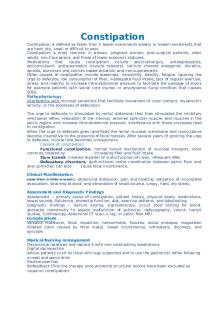
Med Surg GI practice questions
- 23 Pages

Lab6 - lab6
- 2 Pages

Exam 2 Med Surg 2 Practice Questions
- 16 Pages
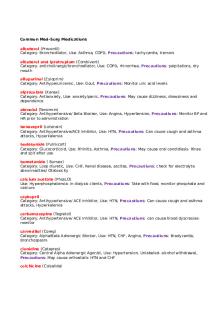
Common Med Surg Meds
- 7 Pages

Med surg dorris bowman
- 4 Pages
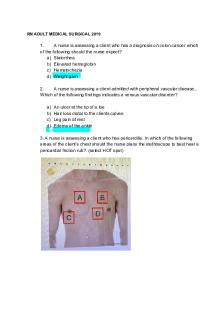
Med surg - notes
- 28 Pages
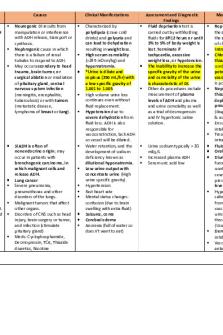
Med-Surg Endocrine
- 11 Pages
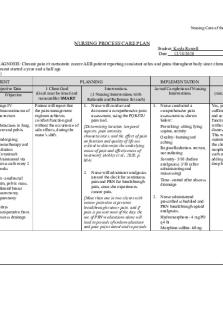
Med Surg- Care Plan
- 6 Pages
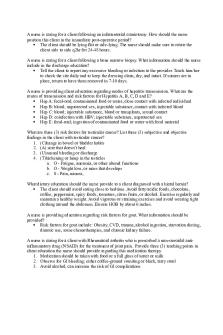
Med-Surg Capstone remediation
- 4 Pages

Med Surg Exam 3
- 19 Pages
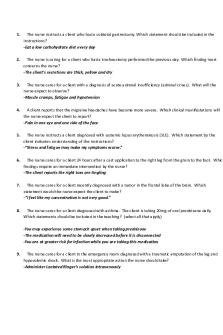
Kaplan med surg 2
- 8 Pages
Popular Institutions
- Tinajero National High School - Annex
- Politeknik Caltex Riau
- Yokohama City University
- SGT University
- University of Al-Qadisiyah
- Divine Word College of Vigan
- Techniek College Rotterdam
- Universidade de Santiago
- Universiti Teknologi MARA Cawangan Johor Kampus Pasir Gudang
- Poltekkes Kemenkes Yogyakarta
- Baguio City National High School
- Colegio san marcos
- preparatoria uno
- Centro de Bachillerato Tecnológico Industrial y de Servicios No. 107
- Dalian Maritime University
- Quang Trung Secondary School
- Colegio Tecnológico en Informática
- Corporación Regional de Educación Superior
- Grupo CEDVA
- Dar Al Uloom University
- Centro de Estudios Preuniversitarios de la Universidad Nacional de Ingeniería
- 上智大学
- Aakash International School, Nuna Majara
- San Felipe Neri Catholic School
- Kang Chiao International School - New Taipei City
- Misamis Occidental National High School
- Institución Educativa Escuela Normal Juan Ladrilleros
- Kolehiyo ng Pantukan
- Batanes State College
- Instituto Continental
- Sekolah Menengah Kejuruan Kesehatan Kaltara (Tarakan)
- Colegio de La Inmaculada Concepcion - Cebu


